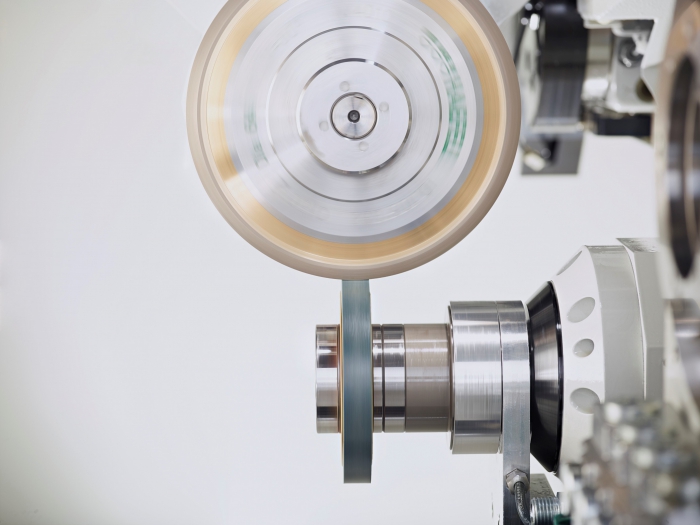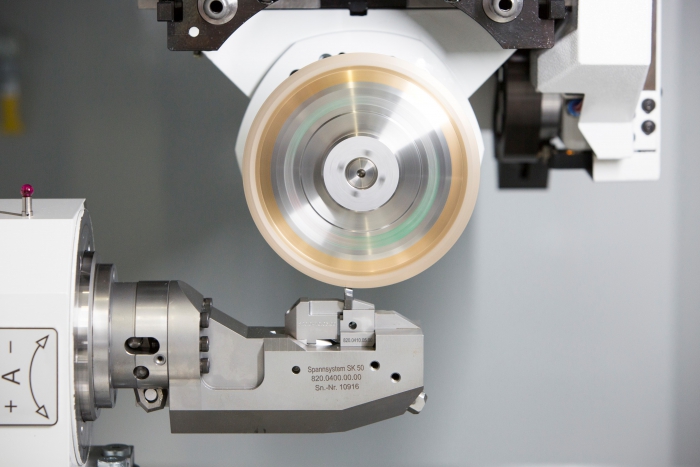Article by Haas Schleifmaschinen GmbH, Trossingen, Swabia
If you want to produce high-precision profile inserts, your tapered diamond grinding wheels need to be dressed on a regular basis. Haas Schleifmaschinen GmbH opts for the profile accuracy of the XING dressing technique inside the machine.
Haas has many customers who manufacture profile inserts, all of whom value maximum dimensional accuracy and surface quality. The Multigrind CU and Multigrind CA are the grinding machines most frequently used. The grinding tool of choice when it comes to machining profile inserts is often the tapered or V-shaped diamond grinding wheel, which has to be dressed – i.e. brought into the correct geometric form – on a regular basis to ensure exceptional grinding results.

XING dressing a tapered diamond grinding wheel, which is positioned at a 90° angle to the dresser wheel. Photos courtesy of Haas Schleifmaschinen
Dressing with profile accuracy
But the extremely precise tapered diamond grinding wheels often feature an edge radius of just a few hundredths of a millimeter and are correspondingly sensitive, which is why we at Haas opt for the XING dressing technique. The dresser wheel axis isn’t positioned parallel to the grinding wheel axis, as it is with other techniques, but rather at a 90° angle, meaning the silicon-carbide or corundum wheel often associated with other diamond grinding wheels can be used for dressing. Thanks to the NC-controlled process, the radius of the grinding wheel can be generated with the circumference of the dresser wheel, thus maintaining a consistent contact surface and pressure between dresser wheel and grinding wheel. The benefits of XING dressing include a lower pressure load and higher profile accuracy for the grinding wheel.

Machining a profile insert for machining on a Multigrind CU grinding machine.
Dressing without unclamping and rechucking
Like all other dressing techniques at Haas, XING dressing is also carried out inside the grinding machine, so there’s no need to unclamp and rechuck the grinding wheel. That has a positive effect on dimensional accuracy, while the grinding wheel boasts better radial and axial runout, making it possible to generate better surfaces. This is something you can actually hear while grinding – the wheel sounds much “healthier” during the grinding process.
Because of the good experiences we’ve had with XING dressing, this technique will be expanded for use in additional applications at Haas. In current projects, we’re applying the technique to profile grinding wheels, grinding pencils or quills and grinding wheels with other grain types, as well as ceramic and hybrid-bonded grinding wheels. As a result, many different wheel contours can be dressed using the Multigrind grinding machines. But this is only possible if the option for direct or indirect wheel probing is available. A noise sensing system is always required for setting up, optimizing, and operating the dressing process. When it comes to V-shaped wheels with a 30° included angle , the wear is highly dependent on previous wheel damage, meaning the existing wear behavior needs to be measured and compensated for.
XING dressing used to be called cross dressing
The mechanical engineers at Haas grin when asked why this dressing techniques is now called XING dressing and no longer cross-dressing. Cross-dressing has nothing to do with grinding technology in English, but instead refers to, according to Wikipedia, “the act of wearing items of clothing and other accoutrements commonly associated with the opposite sex.” What does XING mean? XING is the abbreviation for “crossing” in American English. And that’s a much better fit!
Related Glossary Terms
- dressing
dressing
Removal of undesirable materials from “loaded” grinding wheels using a single- or multi-point diamond or other tool. The process also exposes unused, sharp abrasive points. See loading; truing.
- grinding
grinding
Machining operation in which material is removed from the workpiece by a powered abrasive wheel, stone, belt, paste, sheet, compound, slurry, etc. Takes various forms: surface grinding (creates flat and/or squared surfaces); cylindrical grinding (for external cylindrical and tapered shapes, fillets, undercuts, etc.); centerless grinding; chamfering; thread and form grinding; tool and cutter grinding; offhand grinding; lapping and polishing (grinding with extremely fine grits to create ultrasmooth surfaces); honing; and disc grinding.
- grinding machine
grinding machine
Powers a grinding wheel or other abrasive tool for the purpose of removing metal and finishing workpieces to close tolerances. Provides smooth, square, parallel and accurate workpiece surfaces. When ultrasmooth surfaces and finishes on the order of microns are required, lapping and honing machines (precision grinders that run abrasives with extremely fine, uniform grits) are used. In its “finishing” role, the grinder is perhaps the most widely used machine tool. Various styles are available: bench and pedestal grinders for sharpening lathe bits and drills; surface grinders for producing square, parallel, smooth and accurate parts; cylindrical and centerless grinders; center-hole grinders; form grinders; facemill and endmill grinders; gear-cutting grinders; jig grinders; abrasive belt (backstand, swing-frame, belt-roll) grinders; tool and cutter grinders for sharpening and resharpening cutting tools; carbide grinders; hand-held die grinders; and abrasive cutoff saws.
- grinding wheel
grinding wheel
Wheel formed from abrasive material mixed in a suitable matrix. Takes a variety of shapes but falls into two basic categories: one that cuts on its periphery, as in reciprocating grinding, and one that cuts on its side or face, as in tool and cutter grinding.
- included angle
included angle
Measurement of the total angle within the interior of a workpiece or the angle between any two intersecting lines or surfaces.
- parallel
parallel
Strip or block of precision-ground stock used to elevate a workpiece, while keeping it parallel to the worktable, to prevent cutter/table contact.
